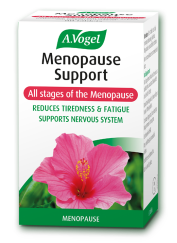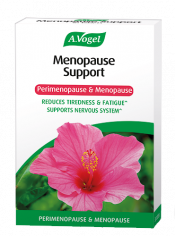Today's topic
Today on A.Vogel Talks Menopause, I'm going to be talking about body shape changes in the menopause and why this can happen.
Unfortunately, as we get older, our body shape can change with age and the fat distribution may change. Fat may increase, and our muscle mass can decrease. All of that changes our shape. What happens when we go through the menopause is that falling oestrogen can affect those changes further and more deeply.
What I'm going to look at today is what changes can happen, why they happen, and what you can do to help yourself. So, we're going to look at four different body shape changes.
1. Fat distribution/Belly fat
Probably the number one for a lot of women is that you start to put on weight round the belly. Instead of being pear-shaped with a waist and slightly more shape to our hips and our thighs, the weight starts to increase in the middle and we can become more of an apple-shaped person. We become much rounder in the middle.
It's not just a case of eating more than necessary but it is a typical stress response. In menopause, we are likely to be extra stressed physically because of all the changes that are going on. We are also more prone to stress and more vulnerable to external stressors so our life can become much more stressful on a daily basis. We may not be aware of it, but our body certainly is. Our body sees this as danger and the fight-or-flight instinct comes into play. We need to have an energy reserve so that when this happens, we have the energy to fight or flee.
In today's world, we don't have saber-toothed tigers or any of the other dangers that we had thousands of years ago. However, our nervous systems haven't really adapted to the 21st century so even little things like being extra busy at work, not being able to find your car keys, missing a bus and other little daily irritants will trigger the flight-or-fight response.
If this happens every day, the body will start to make sure that there is some form of energy available to deal with all these crises that happen regularly. It does this by laying down fat in the middle. There's a special little pouch in the inside of the abdomen where fat is laid down. When there is a flight-or-fight trigger, the body can then break this fat down really quickly and use it for energy, for the emergency that is happening.
The problem for a lot of women, is that they see this as just they're eating too much or they're not exercising enough. As a result, they will cut calories and they will exercise more. And all that happens is that it puts more pressure on the flight-or-fight response. The body then thinks there's a famine because there's no food coming in, so it's going to put more fat down. It's also going to slow your metabolism down so you're not burning as much energy as before. If you then exercise like mad - going down the gym, trundling on a treadmill for an hour every single day or going out and doing lots of running - the body sees this as even more energy expenditure and it slows everything down further.
So, the normal ways of dealing with a bit of weight increase is totally counterproductive. I had one lady who contacted me. She was down to 800 calories a day and she was an hour at the gym, 5 days a week. She was still putting on weight. It was no wonder, because her body would have been in this terrible emergency situation.
For fat round the middle, you really need to look at fooling the body. You need to eat well but you need to eat the right things. I go into this further in my blog 'Menopause Belly Fat & How to Lose it', where I look at the best exercises and the best diet that can help with this particular situation.
2. Loss of muscle size and density
Loss of muscle size and density can be caused by a number of factors. If you're going through the menopause, it could be joint aches and pains which is hindering exercise. It can be fatigue - how can you go out and run, exercise and be active when you're feeling really, really tired?
It can be lack of protein in your diet. Your protein needs go sky-high during menopause and post-menopause. Make sure that you're getting a nice portion of protein with every meal on a daily basis. It's really important. If you don't have protein, your muscles are not going to rebuild themselves.
For those of you that are vegetarian or vegan, or you really don't like eating a lot of meat or fish, then adding in a plant-based protein powder shake on a daily basis can be one of the best ways to increase your protein intake. These shakes tend to have a really good range of other vitamins and minerals so it's a lovely addition to your daily diet that's going to help with a whole range of things, not just helping to keep your muscles nice, and strong, and healthy.
You need to make sure that you do regular exercise of some kind. Don't push yourself too hard. Try walking 15-30 minutes a day or a small amount of high-intensity interval training two or three times a week.
If you like swimming, riding your bike or any of exercise where you're really using your muscles, this can help to increase muscle density and strength. The weaker your muscles are, especially the big, weight-bearing muscles, the more vulnerable you are to joint issues such as arthritis. If your muscles are weak, they will not be able to stabilise your joints. It's really important to have this combination to help to strengthen muscles.
3. Breast size changes
Breast changes are very common during menopause. As we go through menopause, they can lose their pertness. They can start to sag. They can start to completely lose their shape and their density and they become a lot less firm.
For a small number of women, breasts can actually increase, which is very often due to a specific type of hormonal change. This is a really difficult one to sort, but you may find that plant oestrogen supplements can be of some benefit. Some women find kelp supplements can be really effective. Calcium and magnesium supplements can sometimes help to support the breast as well. Dehydration can affect breast structure, so just make sure you're drinking plenty of water.
The other thing to do is when breasts change is to make sure that you are wearing the correct size bra. A few years ago, I decided that because things were changing for me, I'd probably need to get my breast size checked. I was mortified because I discovered I'd been wearing the wrong size bra for probably about 20 years.
If your breasts are sagging a little bit, that can affect your shoulders and back muscles, giving you backache. So, getting the right size bra can lift you up. It can accentuate your waist and it can make you look slimmer. A lot of the big stores are now offering free measuring service so it really is worth it, both to help support your breasts but also to help you feel better about the changes that are going on. I would definitely recommend getting that done.
4. Posture changes
Again, posture changes can be caused by a number of issues. Our bones get weaker. Our spine gets less stable, so we tend to be less upright. We end up slouching more.
I do a lot of desk work and regardless of how focused I am on posture, by the end of the day, I usually find I'm slouching, which is not good for my back, my neck or my shoulders. It's about being aware of your posture and just trying to keep that in mind, especially when you are sitting.
For this particular one, it may be a good idea to check out different exercises you can do, such as the Alexander Technique. This is a fabulous one for improving posture.
You've also got things like Pilates. If you do find you're getting an achy neck, shoulders and back, then maybe have a consultation with a chiropractor. They can very often find if things are slightly out of balance.
Another little tip is if you are having problems with your feet, that can then transfer into spinal issues, which can affect your posture. If you're getting sore ankles, or sore feet, check with a podiatrist, because they can sometimes manipulate your ankles, and that can have a great effect on improving your spine and your posture.
What else can help?
Looking at all these changes, it's all very well for me to say, "Embrace your new shape." It's a difficult one but we all have to do it. My shape has changed and sometimes, we can feel less feminine or we just don't feel the same about ourselves. Our confidence can go but it's about realising that we can enhance the changes by doing things like getting new bras and sometimes, dressing differently can help too.
A good number of years ago, I did two things. I got my colours done, which means that somebody will help you choose the colours that suit your skin tone. For me, it was all the pastel, bright colours, the purples, black, white, sort of cherry reds and bright greens which all enhance my skin tone and my colour. If I were to wear browns, yellows, and creams, I would look ill. That has happened before. I've come into work with the wrong colour on and people ask, "Are you all right?"
Getting your colours done can make a huge difference to how you feel about yourself and makes you look better - the colours will enhance how you feel.
The other thing I did was in a lot of big stores now they are offering a free service whereby someone will come and show you the best type of clothes to wear for your body shape. Again, it made a huge difference to how I felt about myself because she showed me clothes that normally I wouldn't have even touched made such a difference. For me, now, shopping, I know which colours to look for and I know which style of clothes to look for. That helped me to feel better about myself.
Other things to remember - manage your stress, especially if it's weight round the middle, eat well and exercise regularly, even if it's just a 15-30 minute walk each day.
I hope you found this one helpful. If any of you have any tips as to how you have managed with the body changes that have gone on for yourself and what have you done to make yourself feel better, please share them because this can make a lot of difference for a lot of women.
Until next week, take care.








